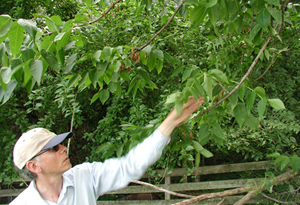| Collecting Ash Seed |

|
Collecting Ash Seed: What Populations to Collect

Collecting seed from low-hanging branches
The most critical areas to sample are those closest to EAB infestations. The trees in those areas will be totally or largely lost if immediate efforts are not made to preserve them. A distribution map showing all identified Emerald Ash Borer infestations and quarantine areas is shown in our Maps area and is regularly updated on the Internet at:
http://emeraldashborer.info/files/MultiState_EABpos.pdf.
We would like to focus seed collections on states with infested counties and surrounding areas. Our initial focus will center on the five most widespread Fraxinus species in eastern North America:
- F. americana L. (white ash)
- F. nigra Marshall (black ash)
- F. pennsylvanica Marshall (green and red ash)
- F. profunda (Bush) Bush (pumpkin ash)
- F. quadrangulata Michx. (blue ash)
Range maps of these are shown in our Maps area.
Ideally, the full ecogeographic ranges of these species will be sampled in a stratified fashion. In part, this can be accomplished by acquiring samples from as many Omernik Level III ecoregions as possible from throughout the native ranges. A copy of the Omernik Level III ecoregion map for North America can be obtained from:
ftp://ftp.epa.gov/wed/ecoregions/cec_na/NA_LEVEL_III.pdf. (Note: This takes some time to download)
Guidelines for collecting seed
Fraxinus species are widespread throughout the eastern and central United States, with other North American taxa found in isolated parts of the southwestern and western United States. Trying to identify suitable native populations of Fraxinus that are worthy of collecting comes with experience and can initially be difficult. However, a few simple guidelines can be followed in order to ensure high-quality samples are collected:
- Target population size. In a project of this type, there is an obvious trade-off between sampling many mother trees within a population and sampling fewer trees but more populations. A "lower-end" sampling target would be to collect from 5 productive mother trees within a stand. An "upper-end" sampling target would be to represent a population by harvesting from 25 to 30 mother trees, ideally within about 300 yards of each other in a dense ash stand. According to Brown and Marshall (1995), at least one copy of 95% of the alleles occurring in the population at frequencies of greater than 0.05 can be captured by sampling from 30 individuals throughout a population for an outbreeding sexual species. In cases where mature trees are scattered through a continuous forest or along a corridor, the 300-yard distance is not a fixed limit. Please note that while the 25-tree sample may be appropriate for a thorough sampling of within-population variation, we realize that this isn't always feasible and can even hinder the sampling of a sufficient number of diverse populations within a region (see Sample Widely below). We do not want to reject populations just because they only have 5 to 15 mother trees with good seed production, and many of the population samples that we have been accessioning are based on less than 25 mother trees.
- Natural areas. Collections should be made in natural areas (e.g. state parks well away from campgrounds and other planted areas, preserves, national forests, conservation areas, etc.) from naturally growing trees of wild origin, not planted or cultivated. This ensures that locally-adapted populations are properly represented.
- Isolation. Observations should be made to determine if non-local ash trees have been planted in the area (e.g. reforestation, building plantings, urban landscapes, etc.). Please note that seeds should not be collected from trees even if they are believed to be of local origin when there are mature, planted ash trees (generally staminate clones) of unknown origin close enough to cross-pollinate. It is difficult, if not impossible, to determine which staminate trees have contributed to the seed trees being collected, without careful genetic testing, so we want to err on the side of caution. Targeting those areas most distant from urban and/or planted areas is preferred.
- Request landowner permission. Ownership of potential collection sites must be verified (either during pre-trip planning or initial field reconnaissance) so proper permission can be obtained from landowners and/or site managers. Such permission should be noted in the documentation provided with each collection.
- Sample widely. Due to the limited time and resources that can be devoted to these efforts, population diversity should be maximized by selecting target populations that are expected to differ significantly from others already collected, based on either geographic distance or habitat/soil-type variation. Within a given Omernik Level III ecoregion, it is best to sample widely rather than to select too many populations from a concentrated area. Within a population, it is also worthwhile to sample widely, selecting diverse mother trees that display variation in age, phenology, and morphological and color traits.
